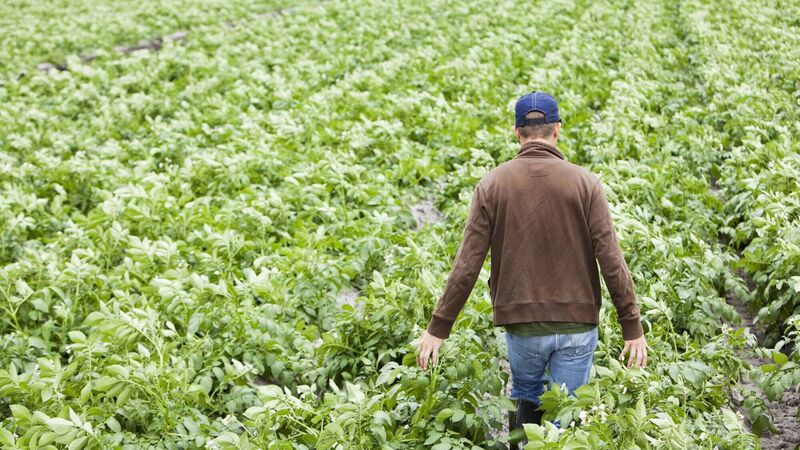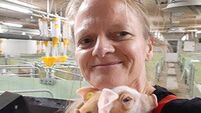Lack of supply, markets, and a fair price in Ireland’s organic farming sector

Bord Bia says there is a need to look at the demand for organic food in Ireland and overseas. File Picture.
There is one purchaser of organic beef in Ireland with a premium of just 12% being paid for the product compared with commercial beef.
40% of Ireland’s organic beef is being sold as commercial beef while three-quarters of organic lamb is being lost to commercial sale.
And, the delivery of processing outlets for organic produce must be part of the country’s organic farming goals.
This is what emerged during a meeting of the Joint Committee on Agriculture which discussed Organic Farming in conjunction with Teagasc, Bord Bia, and the Department earlier this week.
Colin Hayes, Assistant Secretary-General with responsibility for organics at the Department told the meeting, organic farming in Ireland was at 1.8% compared to the EU average of 7.5%, and production here was “not fully aligned” with market opportunities.
“Most organic farmers engage in beef and sheep production with growth on the domestic market anticipated in fruit, vegetables, and dairy,” he added.
“At the moment, there is insufficient supply to meet demand, and growth in the dairy and beef sector is being impeded by the insufficient supply of organic cereals and proteins.”
Mr Hayes also highlighted how the sector supported the EU’s Farm to Fork strategy and Green Deal initiative and pointed to the importance of the three main initiatives in Ireland which include the Organic Farming Scheme, Organic Capital Investment Scheme, and the Organic Processing Investment Grant Scheme.
Padraig Brennan, Bord Bia, said there was a need to look at the demand for organic food both domestically and further afield.
He pointed out how the Bord has seen a growth in demand for organic produce domestically over the past 12 months with an increase of 16% experienced in retail sales.
“Over the last few years we have seen a growth in the number of organic producers and this year’s Organic Farming Scheme will see more producers coming through,” he continued.
“But with regard to the producers that are there and looking at the sheep sector, there is considerable leakage of organic store lambs into the conventional sector.
“Three out of every four store lambs that are being reared organically are being lost to that and are therefore not slaughtered or processed as organic lamb.
“If we could minimise that from happening we could increase supply.”
Mr Brennan went on to say that the level of imports regarding fruit and vegetables coming into the Irish market was “very, very high” and he pointed out that some of those products can be produced here while others could be produced “if the price was right”.
“There is potential for more supply coming through, which is very positive, but we need to maximise what is being produced on the ground as much as we can,” he added.
“Bord Bia is looking at ways to develop the domestic market further and to make the most of opportunities overseas.
“If you look at the cereal sector, at the moment Ireland is only producing about half of the demand that is there for organic oats.
“If we can get growers then there is potential there.
“If we could get more cereal growers into the system we could reduce our reliance on imported animal feed as well.
“There are customers out there for Irish organic beef but we need a level of scale to meet that demand.”
Meanwhile, Professor Gerry Boyle, Teagasc, pointed to organic produce and sustainability.
He highlighted how Teagasc now has 100 farms across the country that will demonstrate ‘sustainability in action’ on farms.
The plan, he added, is to have five organic farms represented in that network.
“That will give us the opportunity to link the credentials associated with organic production and sustainability,” said Professor Boyle.
“From a marketing perspective, both of those credentials should reinforce each other.
“Organic farms and organic produce will have a lower carbon footprint and will also benefit biodiversity and water quality.
“Organic farming leads to much fewer ammonia emissions.
“All of this should be a marketing strength particularly in export markets.”
He went on then to highlight one of the programmes that Teagasc is running which focuses on zero nitrogen application, which he added: “is replicated in the organic context”.
“We are also doing expensive work on our multi-species swards and that too can be carried over into the organic sphere.”
Deputy Michael Collins, meanwhile, put a human perspective to proceedings.
An organic farmer for 20 years - until he handed over the reins to his son last year - Mr Collins said the entire setup in Ireland was “a farce”.
“The price of cattle never changed; if you were living in a peripheral area there was no opportunity to sell your cattle,” he continued.
“There was one buyer up the country and it was very difficult to find a market.
“In my view, the marts should be used around the time when weanlings are being sold to sell organic cattle.
“We have a great scheme in the Organic Farming Scheme and that scheme just needs to be developed further and enhanced.
“The bottom line is that organic farmers are not getting the price for their cattle and if they are not getting the price then that is discouraging, particularly for young farmers who want to farm organically.”
In response to Deputy Collins, Mr Brennan said that an organic finished animal was selling at between €4.90-€5kg - a 10-12% premium above the average of a conventional animal.
He highlighted how there was “stability” in the organic cattle price whereas conventional cattle price experiences “fluctuation” - which has been going through a strong period over the last few months.
He also said there was a need to “co-ordinate supply”.
“There is a considerable leakage of animals from the organic sector when they come through a livestock mart, so I think if we could co-ordinate that better we would have more supply available,” continued Mr Brennan.
“We would then be in a position to supply some of the opportunities that exist not just on the Irish market but also overseas.
“There is work to be done at an overall sector level; when you have a producer that has gone to the effort of converting to an organic enterprise, then it is necessary that their supply continues on in an organic channel right the way through to slaughter.
“I think that would help in terms of the average price return as well.”


